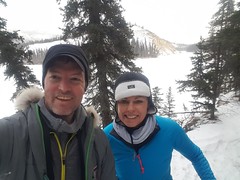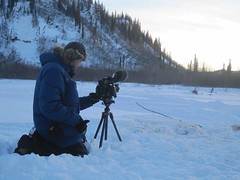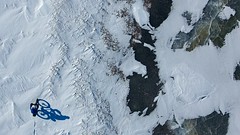
Expedition Overview
Beginning on 15th March 2017, Breaking the Cycle Yukon was a 4-week extreme cold training expedition through the Canadian Arctic. Working with local expert Bob Daffe, who has been exploring and guiding in Yukon for more than 40 years, I followed a route of approximately 900km from Fort McPherson on the Dempster Highway to Aklavik by ice road, then cross-country to Shingle Point on the Beaufort Sea. The team returned to Aklavik and I then followed ice roads across the Mackenzie River Delta, firstly to Inuvik and finally to Tuktoyaktuk, the most northerly town accessible by road in Canada.
Why undertake this extreme challenge?
I set myself this extreme challenge to test the equipment and clothing systems I plan to use in Antarctica and hone my own skills for riding in extreme cold conditions in the soft snow. However, Breaking the Cycle Yukon was a unique, major expedition in it’s own right. The route from Aklavik, along the Peel and Moose channels and across the Beaufort Sea to Shingle Point, has never been cycled before. We were able to meet with indigenous peoples of the region, witness evening displays of the Aurora Borealis (Northern Lights) and gain an appreciation for the harsh beauty of an Arctic winter environment.
Testing equipment and clothing
Steve Christini custom-built a third, slightly improved version of his all-wheel drive fatbike. The main difference with Mark III is that it is the first version that can accept VEE Tire’s 5.05″ (13cm) wide Snowshoe 2XL tyre on the rear for maximum flotation. This is the widest tyre available on the market. The tyre is HUGE!
Cycling through snow is incredibly hard work – about as tough as it gets. An added difficulty cycling in the extreme cold is to manage moisture because if I perspire and then stop to rest, any sweat freezes. When this happens next to the skin, it is a real problem because it could lead to cold damage (frost nip, even frost bite and hypothermia) and it draws energy away from the body. The art of polar travel is to manage the body temperature by wearing the right combination of wind-resistant but breathable layers that also wick moisture away so that it does not freeze against the skin. I refined some of these clothing systems during the expedition.
There were plenty of options to try thanks to Mont Australia, Velocio, The Heat Company, Julbo, 45NRTH, Revelate Designs and Wilderness Wear.
The expedition
After preparing all equipment, food and clothing in Whitehorse, Bob and I, drove 550km to Dawson City and then to the start of the Dempster Highway, about 40km from Dawson. From there I began a three day acclimatisation ride in an attempt to get accustomed to the cold. Coming out of an Australian summer, the 60C difference in temperature was a huge shock to my body. I suffered a lot from the cold on this ride, but enduring the shock was a necessary step to be ready for the main challenges. In Fort McPherson we were joined by expedition filmmaker, Claudio von Planta, and Bob’s wife Theresa.
Our first plan was to follow a recently made snowmobile track to the remote community of Old Crow, 250km to the west. Old Crow is normally only accessible by airplane or, in winter, by this snowmobile track. The first stage, 56km up the valley of Stoney Creek, was magical and the conditions for cycling were favourable. Near the creek’s headwaters, the route became impassable by overflows and we were forced to take a diversion over high open plains. The landscape was carpeted with high tufty, spongey grasses that caused the snow cover to be pocked with deep holes. The surface was virtually unrideable as my wheels would sink without warning into sometimes knee-deep soft patches. I struggled all day and pushed for all but 2-3km.
We then found that the next creek was also not navigable by snowmobile (Bob and Theresa had scouted ahead and both had experienced mishaps trying to get through the creek). The alternative was to traverse many more kilometres of the tufty grass plains. I would have been pushing for several days and then been confronted with a mountain pass. As Old Crow is not accessible by any other route, we would have then had to retrace the same path back again. We decided to return to Fort McPherson and adapt our plans to be able to cover more territory and make better use of out limited time.
From Fort McPherson, I took a little-used ice road, following 160km along the meandering Peel Channel to the indigenous community of Aklavik. Essentially we approached the original route that Bob suggested from the opposite direction.
From Aklavik I embarked on the main challenge of the expedition, to make the first bicycle journey to Shingle Point. In summer, the rich fishing waters around Shingle Point are a four hour boat trip from Aklavik. In winter, snowmobile is normally the only way to access the region. Locals tend to use the route for hunting game. The winter route followed softer snow up the wide Peel Channel. We then turned west into Moose Channel, a much narrower waterway that wriggled across the western periphery of the Mackenzie River Delta and eventually out to the open sea.

For me this was the most special part of the expedition where I was confronted with conditions most similar to what I am likely to find in Antarctica. Up until this point, my body had been suffering from the cold; my legs were constantly swollen and my face was puffed up for much of the time. Somehow, on the most physically demanding part of the journey, where the energy requirements are probably 3-4 times higher than for normal cycling, my body seemed to respond positively. The swelling vanished. This was a great result and despite many bruises and a strained ankle from a series of heavy falls on the glare ice on the Beaufort Sea, I came through fitter, stronger and unscathed.

The final phase of the expedition was to cycle the Aklavik ice road to Inuvik and then the famous ice road along the East Channel of the Mackenzie River Delta to Tuktoyaktuk. Although the surfaces are different to what I will experience in Antarctica, I was still faced with piercing arctic winds, especially on the final day to Tuk. It was a privilege to cycle the 187km length of the Inuvik – Tuk ice road in the last year of its existence. The all-weather Dempster Highway is being extended from Inuvik to Tuk and will be in operation by next winter.

Sponsors (for the Breaking the Cycle Project)
So far include: Dimension Data, Noel O’Brien, Restons Solicitors, Simone Yeo, Australian Geographic, World Expeditions, Aldersley Capital, Velocio, Mont Australia, Christini Technologies, Ibis Cycles, VEE Tire Company, 45NRTH, HED Cycling, The Heat Company, Hilleberg Tents, Revelate Designs, Wilderness Wear, Cycle Works Boxhill, Ortleib, Ride Mechanic and several private sponsors.










































